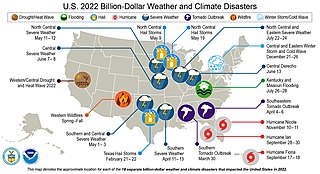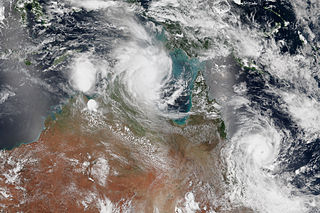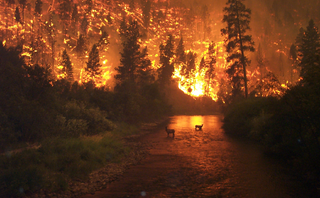
Tropical Storm Allison was a tropical cyclone that devastated southeast Texas in June of the 2001 Atlantic hurricane season. An arguable example of the "brown ocean effect", Allison lasted unusually long for a June storm, remaining tropical and subtropical for 16 days, most of which was when the storm was over land dumping torrential rainfall. The storm developed from a tropical wave in the northern Gulf of Mexico on June 4, 2001, and struck the upper Texas coast shortly thereafter. It drifted northward through the state, turned back to the south, and re-entered the Gulf of Mexico. The storm continued to the east-northeast, made landfall on Louisiana, then moved across the southeast United States and Mid-Atlantic. Allison was the first storm since Tropical Storm Frances in 1998 to strike the northern Texas coastline.

Typhoon Lingling, known in the Philippines as Typhoon Nanang, was a deadly typhoon that struck the Philippines and Vietnam in 2001 and caused 379 deaths. The name "Lingling" was given by Hong Kong. The 39th tropical depression, 22nd named storm, and 13th typhoon of the 2001 Pacific typhoon season, Lingling developed into a tropical depression on November 6 and given the local name Nanang by the PAGASA. The next day, it was upgraded into a tropical storm and given the name Lingling by the Japan Meteorological Agency (JMA). Lingling's intensity briefly stagnated as it moved over Visayas before resuming intensification and intensifying into a severe tropical storm on November 8. One day later, both the JMA and the Joint Typhoon Warning Center (JTWC) upgraded Lingling to a typhoon as it exited the Philippine archipelago and moved into the South China Sea. After intensifying into a typhoon, Lingling began to quickly intensify, peaking with 10-min sustained winds of 155 km/h (96 mph) and 1-min sustained winds of 215 km/h (134 mph), with a minimum central pressure of 940 mbar (28 inHg). Lingling began to weaken as it approached the Vietnamese coast, before making landfall on November 11 at 18:00 UTC. Lingling rapidly weakened afterward, dissipating on November 12.

The following is a list of weather events that occurred on Earth in the year 2020.

During 2000, tropical cyclones formed in seven different areas called basins, located within various parts of the Atlantic, Pacific, and Indian Oceans. A total of 140 tropical cyclones formed within bodies of water known as tropical cyclone basins, with 81 of them being further named by their responsible weather agencies when they attained maximum sustained winds of 35 knots. The strongest storm of the year was Cyclone Hudah, peaking with a minimum pressure of 905 hPa (26.72 inHg), and with 10-minute sustained winds of 220 km/h (135 mph). The highest confirmed number of deaths from a storm was from Typhoon Kai-tak, which killed 188 people, however, Leon–Eline may have killed up to 722 people. The costliest storm was Saomai, which caused $6.3 billion in damage. The accumulated cyclone energy (ACE) index for the year 2000, as calculated by Colorado State University was 677.3 units.

The following is a list of weather events that occurred in 2021. The year began with La Niña conditions. There were several natural disasters around the world from various types of weather, including blizzards, cold waves, droughts, heat waves, tornadoes, and tropical cyclones. In December, powerful Typhoon Rai moved through the southern Philippines, killing 410 people and becoming the deadliest single weather event of the year. The costliest event of the year, and the costliest natural disaster on record in the United States, was from a North American cold wave in February 2021, which caused $196.4 billion (USD) in damage; the freezing temperatures and widespread power outages in Texas killed hundreds of people. Another significant natural disaster was Hurricane Ida, which struck southeastern Louisiana and later flooded the Northeastern United States, resulting in $70 billion (USD) in damage. December saw two record-breaking tornado outbreaks, only four days apart from each other. In Europe, the European Severe Storms Laboratory documented 1,482 weather-related injuries and 568 weather-related fatalities. The National Oceanic and Atmospheric Administration documented 796 weather-related fatalities and at least 1,327 weather-related injuries in the United States and the territories of the United States.

The following is a list of weather events that occurred on Earth in the year 2022. The year began with a La Niña. There were several natural disasters around the world from various types of weather, including blizzards, cold waves, droughts, heat waves, wildfires, floods, tornadoes, and tropical cyclones. The deadliest weather event of the year were the European heat waves, which killed over 26,000 people, 11,000 of which were in France. The costliest weather event of the year was Hurricane Ian, which caused at least $112.9 billion in damages in Florida and Cuba. Another significant weather event was the Pakistan floods, which killed 1,739 people and a total of $14.9 billion in damages.
The following is a list of weather events in 2019.

The following is a list of weather events that occurred in 2018.

The following is a list of weather events that occurred in 2017.

The following is a list of weather events that occurred in 2016.

The following is a list of weather events that occurred on Earth in the year 2004. There were several natural disasters around the world from various types of weather, including blizzards, cold waves, droughts, heat waves, tornadoes, and tropical cyclones. The deadliest disaster was Hurricane Jeanne, which killed more than 3,000 people when it struck Hispaniola, mostly in Haiti. This was just four months after flooding in Hispaniola killed 2,665 people. Jeanne was also the fourth hurricane to strike the United States in the year, following Charley, Frances, and Ivan. Ivan was the costliest natural disaster of the year, causing US$26.1 billion in damage in the Caribbean and the United States.

The following is a list of weather events that occurred on Earth in the year 2014. There were several natural disasters around the world from various types of weather, including blizzards, cold waves, droughts, heat waves, tornadoes, and tropical cyclones. In September, floods in India and Pakistan killed 557 people. The costliest single event was Typhoon Rammasun, which killed 225 people and left over US$8 billion in damage when it moved through the Philippines, China, and Vietnam.

The following is a list of weather events that occurred on Earth in 2015. There were several natural disasters around the world from various types of weather, including blizzards, cold waves, droughts, heat waves, tornadoes, and tropical cyclones.

The following is a list of weather events that occurred on Earth in the year 2023. The year saw a transition from La Niña to El Niño, with record high global average surface temperatures. The several weather events which had a significant impact were blizzards, cold waves, droughts, heat waves, wildfires, floods, tornadoes, and tropical cyclones.

The following is a list of weather events that occurred in 2011. The year began with La Niña conditions. There were several natural disasters around the world from various types of weather, including blizzards, cold waves, droughts, heat waves, tornadoes, and tropical cyclones.

The following is a list of weather events that occurred on Earth in the year 1985. The year began with a La Niña. The most common weather events to have a significant impact are blizzards, cold waves, droughts, heat waves, wildfires, floods, tornadoes, and tropical cyclones. The deadliest weather event of the year was the Ethiopia famine, which killed at least 400,000. The costliest weather event of the year was Hurricane Juan, which caused around $1.5 billion in damages in the Southern United States. Another significant weather event was the Bangladesh cyclone in May, which killed 11,069 people and damaged nearly 100,000 houses.

The following is a list of weather events that occurred on Earth in the year 2000. There were several natural disasters around the world from various types of weather, including floods, droughts, heat waves, tornadoes, and tropical cyclones. The deadliest disaster were the 2000 Mozambique Floods which killed 800 people, and the costliest event of the year was Typhoon Saomai, which caused $6.3 billion in damages.


















